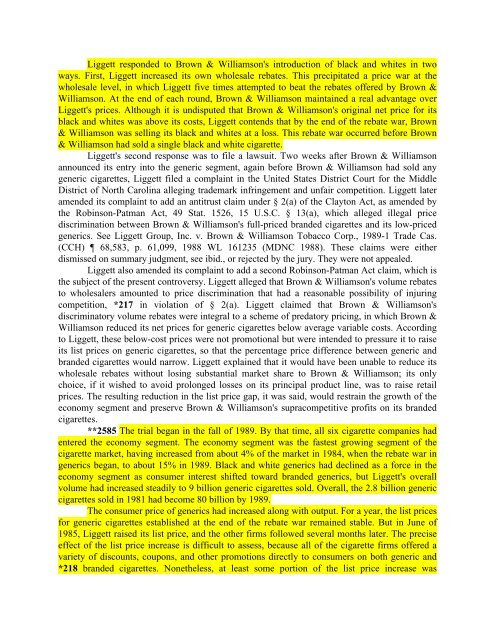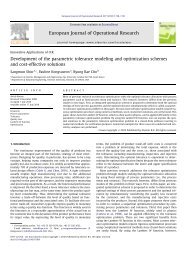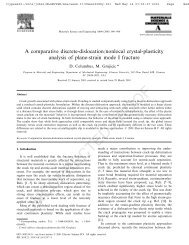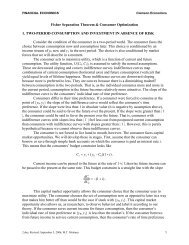509 U.S. 209, 113 S.Ct. 2578 BROOKE GROUP LTD., Petitioner v ...
509 U.S. 209, 113 S.Ct. 2578 BROOKE GROUP LTD., Petitioner v ...
509 U.S. 209, 113 S.Ct. 2578 BROOKE GROUP LTD., Petitioner v ...
You also want an ePaper? Increase the reach of your titles
YUMPU automatically turns print PDFs into web optimized ePapers that Google loves.
Liggett responded to Brown & Williamson's introduction of black and whites in two<br />
ways. First, Liggett increased its own wholesale rebates. This precipitated a price war at the<br />
wholesale level, in which Liggett five times attempted to beat the rebates offered by Brown &<br />
Williamson. At the end of each round, Brown & Williamson maintained a real advantage over<br />
Liggett's prices. Although it is undisputed that Brown & Williamson's original net price for its<br />
black and whites was above its costs, Liggett contends that by the end of the rebate war, Brown<br />
& Williamson was selling its black and whites at a loss. This rebate war occurred before Brown<br />
& Williamson had sold a single black and white cigarette.<br />
Liggett's second response was to file a lawsuit. Two weeks after Brown & Williamson<br />
announced its entry into the generic segment, again before Brown & Williamson had sold any<br />
generic cigarettes, Liggett filed a complaint in the United States District Court for the Middle<br />
District of North Carolina alleging trademark infringement and unfair competition. Liggett later<br />
amended its complaint to add an antitrust claim under § 2(a) of the Clayton Act, as amended by<br />
the Robinson-Patman Act, 49 Stat. 1526, 15 U.S.C. § 13(a), which alleged illegal price<br />
discrimination between Brown & Williamson's full-priced branded cigarettes and its low-priced<br />
generics. See Liggett Group, Inc. v. Brown & Williamson Tobacco Corp., 1989-1 Trade Cas.<br />
(CCH) 68,583, p. 61,099, 1988 WL 161235 (MDNC 1988). These claims were either<br />
dismissed on summary judgment, see ibid., or rejected by the jury. They were not appealed.<br />
Liggett also amended its complaint to add a second Robinson-Patman Act claim, which is<br />
the subject of the present controversy. Liggett alleged that Brown & Williamson's volume rebates<br />
to wholesalers amounted to price discrimination that had a reasonable possibility of injuring<br />
competition, *217 in violation of § 2(a). Liggett claimed that Brown & Williamson's<br />
discriminatory volume rebates were integral to a scheme of predatory pricing, in which Brown &<br />
Williamson reduced its net prices for generic cigarettes below average variable costs. According<br />
to Liggett, these below-cost prices were not promotional but were intended to pressure it to raise<br />
its list prices on generic cigarettes, so that the percentage price difference between generic and<br />
branded cigarettes would narrow. Liggett explained that it would have been unable to reduce its<br />
wholesale rebates without losing substantial market share to Brown & Williamson; its only<br />
choice, if it wished to avoid prolonged losses on its principal product line, was to raise retail<br />
prices. The resulting reduction in the list price gap, it was said, would restrain the growth of the<br />
economy segment and preserve Brown & Williamson's supracompetitive profits on its branded<br />
cigarettes.<br />
**2585 The trial began in the fall of 1989. By that time, all six cigarette companies had<br />
entered the economy segment. The economy segment was the fastest growing segment of the<br />
cigarette market, having increased from about 4% of the market in 1984, when the rebate war in<br />
generics began, to about 15% in 1989. Black and white generics had declined as a force in the<br />
economy segment as consumer interest shifted toward branded generics, but Liggett's overall<br />
volume had increased steadily to 9 billion generic cigarettes sold. Overall, the 2.8 billion generic<br />
cigarettes sold in 1981 had become 80 billion by 1989.<br />
The consumer price of generics had increased along with output. For a year, the list prices<br />
for generic cigarettes established at the end of the rebate war remained stable. But in June of<br />
1985, Liggett raised its list price, and the other firms followed several months later. The precise<br />
effect of the list price increase is difficult to assess, because all of the cigarette firms offered a<br />
variety of discounts, coupons, and other promotions directly to consumers on both generic and<br />
*218 branded cigarettes. Nonetheless, at least some portion of the list price increase was
















